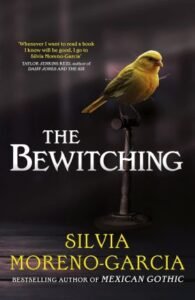The Bewitching by Silvia Moreno-Garcia (book review).
One of the pieces of advice often given to aspiring authors is to write about what they know. While this is difficult when imagining a scenario that is in the far future or in space, where no-one yet has experience, the behaviour of characters can still reflect what the author is familiar with. It is easier to envisage events in a contemporary narrative or even in near historical fiction where much has already been researched. The important thing is to make it seem authentic to the reader.
In ‘The Bewitching’, Silvia Moreno-Garcia makes it easy for herself on one aspect of the novel. It is written as three separate time periods. We are first introduced to Minerva Contreras in 1998. Much of her life mirrors Moreno-Garcia’s own experiences. Like the author, Minerva is a Mexican studying in America on a scholarship but having to work to pay for her keep. Both listened to their great-grandmothers’ tales about witches in the Mexican countryside. Minerva is doing research on the fictional horror writer, Beatrice Tremblay, and more specifically concentrating on the background to her only novel, ‘The Vanishing’, which was based on an incident that happened when Beatrice was a student at the same college Minerva is now at. She hopes to track down and examine some of the papers that Beatrice left behind in the hope that they will shed light on the incident that prompted the novel. It is through meeting Noah Yates at a party that she manages to get an introduction to his grandmother, Carolyn, who had been a friend of Beatrice when they were at college together in 1934.
Among the papers Minerva gets a chance to study is an account by Beatrice Tremblay of the events that lead up to the disappearance of Virginia Somerset and on which the author’s novel was based. As Minerva can only read it at intervals, Carolyn not permitting her to take it away, Minerva’s story is interspersed with this narrative.
The third strand, told in alternating chapters with the other two, is the story of Minerva’s great-grandmother, Alba, who was a teenage girl in 1908. Her family are farmers, struggling because her father has recently died. Matters become worse soon after Alba’s uncle, Arturo, comes to stay. He is elegant and charming, everything that Alba thinks she wants. He is only a few years older than she is, and she is attracted to him. Then her brother disappears, much in the same way Virginia did in 1934, and animals begin to die for no reason. It is Alba who tells Minerva stories of witches and how to counteract evil spirits.
The three time periods parallel each other in that there are unexplained disappearances, and for Minerva it is one of the students. Each of the disappearants has shown an interest in witchcraft, and Alba, Virginia, and Minerva all experience phenomena that can only be described as supernatural hauntings. It is because of Alba’s stories that Minerva realises what is going on and has the knowledge to counteract the bewitchings. Although it is the same kind of haunting, Alba’s experiences involve a separate bewitching from the latter two. People who were around in 1934 are still in the community in 1998. Many horror novels rely on coincidence for their effect, and this is true here. There are a lot of them.
The novel itself is slickly and enjoyably written, though the fact that the three female protagonists are of a similar age makes it sometimes difficult to differentiate them. That said, I would be happy to read more by this author.
Pauline Morgan
October 2025
(pub: Arcadia, London, 2025. 354 page hardback. Price: £20.00 (UK). ISBN: 978-1-52944-170-3).


